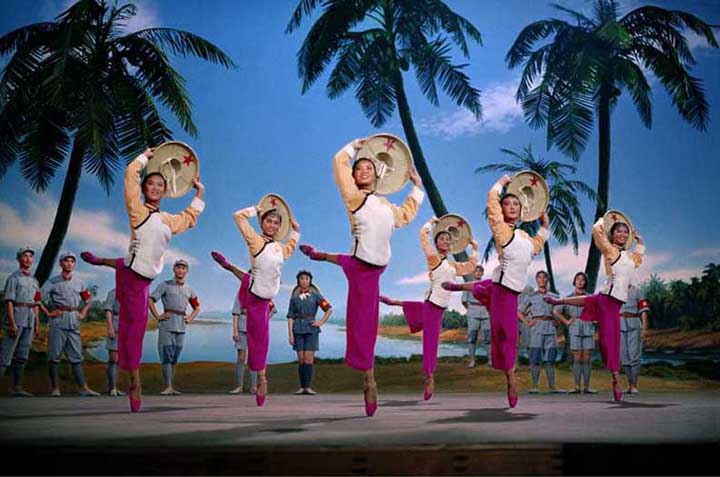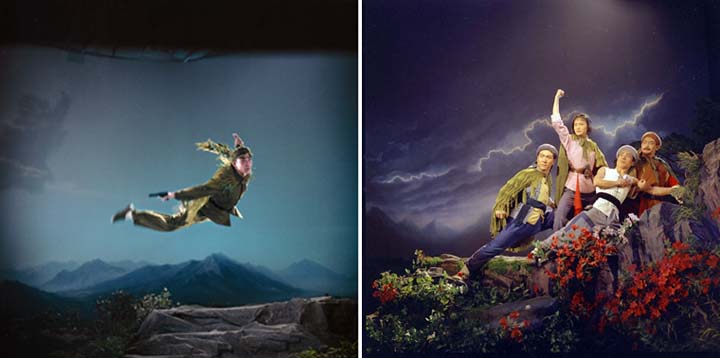Hollywood With Communist Characteristics at Stephen Bulger Gallery
China’s Cultural Revolution (1966-1976) was set into motion by Mao Zedong to remove capitalist, traditional art and imperial cultural elements from Chinese society as a way of instilling Communism. The revolution marked the return of Chairman Mao to a position of power after the disastrous Great Leap Forward, a movement that paralyzed China politically and resulted in tens of millions of deaths through famine and political persecution.
The Chairman’s wife, Jiang Qing, a former actress and a propaganda specialist, became the linchpin of the Cultural Revolution, and masterminded the Model [revolutionary] Opera of the period. She banned traditional Beijing opera with its stories of emperors and concubines, as well as all performances of Western music and movies, which she viewed as having a corrupting influence on the masses.
Instead, she made ordinary peasants and soldiers the heroes of the Model Opera to rekindle their fervor for the class struggle and to further Mao’s edict that “art must serve the interests of the workers, peasants, and soldiers and must conform to proletarian ideology.” The plots of these operas are based on stories of ordinary people struggling to survive while searching for happiness.
But in fact Madame Mao, as she was known, was a great fan of Hollywood films such as The Sound of Music, which she regularly watched in her private screening room. So she wisely adopted what she saw as the power of the Hollywood musical and combined it with traditional Chinese instruments and a strong dose of pro-Communist propaganda in the works she commissioned. She recruited the most talented composers and artists to ensure that the music and dancing were of the highest caliber.

Above: Red Detachment of Women, 1973. © Zhang Yaxin / Courtesy of see+ Gallery Beijing and Stephen Bulger Gallery.
Of the twelve works, eight (five operas, two ballets and a symphony with a Western-style orchestra) were later made into films for mass distribution, and became a pervasive part of everyday life. Author Huo Wang, who lived in China at the time, wrote, "Model operas are the only art form left in the whole of China. You cannot escape from listening to them. You hear them every time you turn on the radio. You hear them from loudspeakers every time you go outside.”
Zhang Yaxin, born in 1933 and a senior photographer at Xinhua News Agency at the time was among the few photographers commissioned to take stills of the operas from 1969 to 1976. His photographs were reproduced on every imaginable surface, from movie posters to postage stamps to decorative ceramics.
"The eight model theatrical works used all the best facilities in China during that time and almost all of the best directors, musicians and actors…were gathered together to create them," Zhang recalled. "I myself benefitted a lot from communicating with them."
Due to the political significance of his assignment, Zhang was given one of only three Hasselblad cameras being used in China during the 1960s and an unlimited supply of scarce Kodak color film. A selection of his Model Opera photographs will go on view Saturday at Stephen Bulger Gallery, in Toronto.

Left: Raid of the White Tiger Regiment, 1971. Right: Azalea Mountain, 1974. © Zhang Yaxin / Courtesy of see+ Gallery Beijing and Stephen Bulger Gallery.
For those who lived through the 1960s and 1970s in China, the Model Operas became an integral part of their lives. Along with Zhang’s images, which were everywhere at the time, the works were the sum total of the Chinese people's cultural experience.
The Dutch-Chinese film director Yan Ting Yuen, whose documentary Yangbanxi: The 8 Model Works won a Sundance Festival award, believes that nostalgia for what might be the best part of a barbaric period is behind the current resurgence of interest in the Model Opera. "It's like if you grow up listening to the Beatles every day, whether you liked them or hated them, the music is still part of your childhood,” she wrote. “So for many people who grew up in China in the 60s and 70s, it's part of their youth. And the music has stood the test of time...it's fantastic."
Zhang Yaxin | Model Opera opens at Stephen Bulger Gallery, with a reception and a screening of Red Detachment of Women, on Saturday, January 26 from 2-5 pm. 1026 Queen Street West, Toronto, ON.


